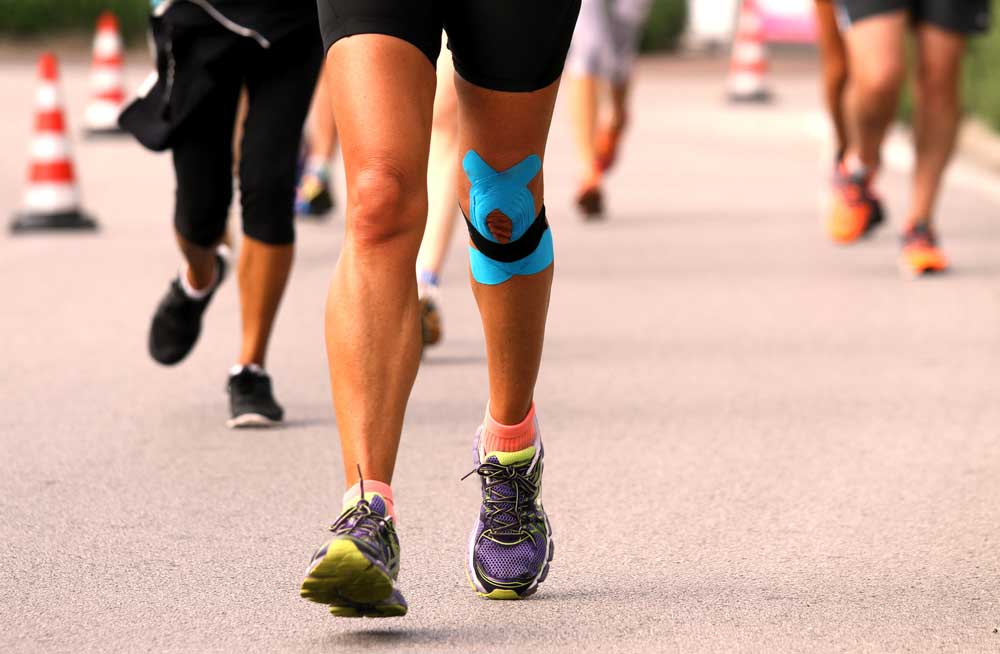
Athletic Taping For Injury Management and Prevention
Sports taping began in the late 1970s with a Japanese chiropractor by the name of Kenzo Kase. Kase worked with many clients including sumo-wrestlers and was responsible for treating injuries and ailments of these competitors. To do so, Kase developed an adhesive flexible, latex-free and water-resistant material that aimed to mimic human skin. When this material is applied to the body, it aimed to provide support and muscles to the joints without restricting movement completely, in comparison to other methods. Kase’s product would, therefore, help athletes recover from their conditions with a full range of motion and help minimise pain without relying on medication or surgery.
Kase went on to sell his product by starting the company ‘Kinesio’ in 1984, hence why athletic taping is sometimes referred to as ‘Kinesio Taping’ in the sports medicine world. However, the taping method failed to gain significant traction until the 2008 Olympics, when US volleyball player, Kerri Walsh, won a gold medal in her sport despite still recovering from surgery in relation to her rotator cuff. Walsh used athletic taping during her events and which allowed her to effectively manage her injury and allow for peak performance free from pain and eliminating the risk of further damage. Since then, many chiropractors, physiotherapists, sports medicine professionals and athletes of all levels have begun to use and endorse taping for sports injury prevention and rehabilitation.
How does sports tape work?
As Kenzo Kase intended, modern athletic tape is designed to mimic the skin’s elasticity without restricting movement. While athletic tape varies amongst brands, most tapes are water resistant and designed with small pores to avoid sweat and water becoming trapped in the tape while engaging in physical activity.
One benefit taping provides athletes of all kinds is the ability to reduce swelling and inflammation. The tape is applied directly on the skin to pull the tissue under the skin, upward. The idea behind this is that when the tissues are pulled upward, the protein filaments become more active and begin to help drain the excess fluid that is released by the injury affected cells.
Sports tape is also believed to help effectively manage pain. In fact, Dotsie Bausch, a 7-time USA Cycling National Champion and 2012 Silver Olympic medallist uses kinesiology tape as opposed to taking ibuprofen and pain medication to reduce her back pain. One lab study published in the Journal of Orthopaedic & Sports Physical Therapy in 2008 aimed to determine the effectiveness of athletic tape in students suffering shoulder pain and determined that the method allowed to improved range of motion. The idea is taping restricts pain related movement allowing for recovery, but doesn’t immobilise the joint altogether. Immobilisation of the joint can create inactivity in the muscle, leading to more injuries in the future, and can also restrict blood flow and oxygen to the injury site. However, oxygen is essential for any tissue injury, as it promotes the healing process.
Furthermore, chiropractic and physiotherapy taping techniques can help prevent further injury. Sprained ankles are amongst the most common sports-related injuries and unfortunately, athletes who have prior ankle sprains are more susceptible to a repeat injury. One study published in 2010 in the Foot & Ankle International Journal found that through the use of sports tape, athletes who have injured their ankles in the past and suffer chronic ankle instability reduce their likelihood to suffer from re-injury.
How do you apply kinesiology tape?
There are a vast array of sports taping and bracing techniques. These vary in relation to the specific athletic tape used, as well as the area you wish to tape to promote recovery or prevent injury. Before applying sports tape it is important you have the correct tape for the job. For example, you can purchase tape of all different sizes and lengths. Ankles will require thicker sports strapping tape while taping the hand, thumb or wrist will require something thinner. It is also essential to never tape over cuts, abrasions and wounds and regular tapers should utilise vitamin E creams to keep their skin in optimal health. The area to be taped should also be clean, dry and shaved to avoid irritation.
Although sports taping techniques vary per joint, there are some common techniques they all share. Our trained sports chiropractors and physiotherapists at our Parramatta, Wetherill Park and Castle Hill clinics can provide more assistance on specific sports injury tape strapping techniques as needed.
However, in order to successfully tape a joint, first place the joint in an appropriate position. To do so you will need to consider the mechanism of the injury, the biomechanics of the sport and the antimony of the area. As an example, a lateral ankle sprain should be placed in dorsiflexion and eversion (up and out) position.
All taping methods include the anchor technique. An anchor is the initial strips of tape which is the foundation of the technique. Any other strips of tape should either start or finish on the anchor strips. Athletic taping methods also always include finishing strips which are applied to hold functional strips in place. The functional strips vary on the joint or injury and include the checkrein, figure 8, locks, spica, spiral and stirrups techniques.
At Spinal & Sports Care, we offer a range of physiotherapy and chiropractic services at our Castle Hill, Parramatta and Wetherill Park locations. For a more personalised approach and to learn more about the most appropriate athletic taping techniques for you, please book an appointment with our talented and professional sports chiropractors and physiotherapists by calling (02) 9683 1110 or booking online.
